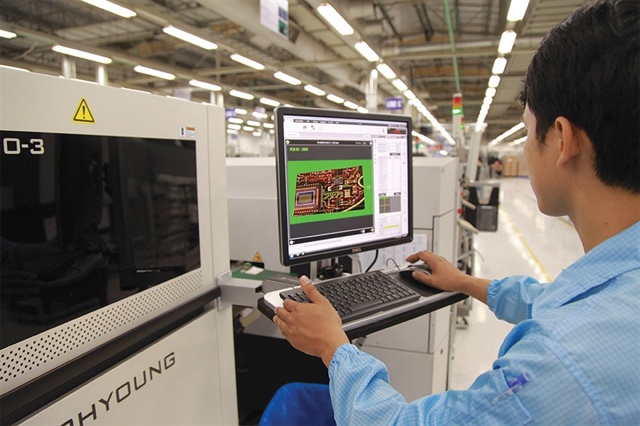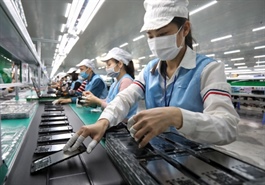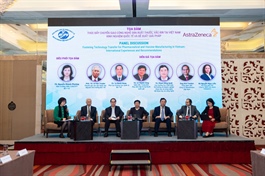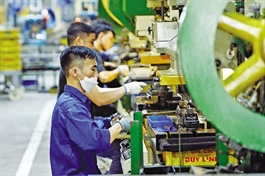Microchip players roll up sleeves
Microchip players roll up sleeves
With numerous positive signals and bustling investment promotion in 2024, Vietnam is emerging as a potential destination for semiconductor supply chains.

Cooperation between government and corporations can lead to major tech breakthroughs, photo Le Toan |
After announcing the establishment of two research centres in Vietnam in early December, US chip manufacturing giant Nvidia immediately announced recruitment for positions from testing engineers to senior managers working in Hanoi and the neighbouring province of Bac Ninh.
“The cooperation agreement with Nvidia is an important push for Vietnam to make a leap forward in technology, and a big spillover effect, attracting the attention of other high-tech investors with investment in AI and semiconductors in Vietnam,” Minister of Planning and Investment Nguyen Chi Dung said at a government meeting on the issue in early December.
He emphasised that tech corporations such as Intel, Amkor, HanaMicron, and Qualcomm have plans to shift their supply chains to Vietnam, not only investing in production and business, but also building research and development (R&D) centres.
The Ministry of Planning and Investment has also worked with representatives of Google, Meta, AlChip, and Qorvo. “Most of them have specific plans to shift their supply chains to Vietnam already, to develop R&D centres, or expand investment, production, and business here,” Minister Dung stated.
Economic expert Nguyen Thuong Lang from the Institute of International Trade and Economics said that in 2018-2019, when the US imposed high tariffs on imported goods from China, there was a wave of foreign capital moving away from China or not expanding investment. Now is deemed a second similar opportunity that Vietnam must seize on.
“The situation for capital movement is different today in that Vietnam has many special advantages in the semiconductor field, including the developments from Nvidia and the operation of large manufacturing plants from Foxconn, Compal, and Pegatron,” Lang said. “Vietnam’s global position has improved and now many corporations identify Vietnam as a destination for high technology, semiconductors, and AI.”
Domestic groups push for progress
Amid this attention from foreign tech giants, Vietnamese enterprises are ready to accelerate the preparation and capacity to join the supply chain. Nguyen Dat, deputy general director of Viettel, said that the company has worked with Nvidia and committed to building and deploying the largest data centre in Vietnam.
“In the first phase of building this centre, Viettel will pour about $100 million in 2025 to purchase equipment, while the infrastructure, electromechanics, and the general condition of this centre have been completed by Viettel,” Dat said.
Minister of Information and Communications Nguyen Manh Hung said that one of the key tasks in 2025 to implement the semiconductor development strategy is the scheme of building a small-scale, high-tech chip factory for research, design, and production.
The minister requested Viettel to plan the implementation of the scheme. “This will be the first Vietnamese chip factory in Vietnam and be a key initial strategic step,” Hung said.
He said that special incentive mechanisms and financial support will be approved for building the factory, and a shared platform and tools are being built as infrastructure for the semiconductor industry as well as for startups and experts.
Elsewhere, FPT has also advanced in the semiconductor industry, with about 200 design engineers working with dozens of customers in Japan, Taiwan, and Vietnam.
In education and training, FPT enrolled 1,500 students in 2024 and has partnered with Nvidia on building its first AI factory in Vietnam, as well as a centre in Japan.
“To realise the dream of the Vietnamese semiconductor industry, we need a strategy to build Vietnamese human resources, and to rank first in ASEAN in the number of newly opened chip design companies, including startups and foreign R&D centres,” an FPT leader said.
FPT proposed that the government continue to direct the creation of a semiconductor diplomatic environment, accompanying businesses as it does now. “We have good relations with major countries and need to continue to maintain these relationships to create joint venture opportunities with major businesses in the semiconductor industry,” he added.
Taking action
However, complexities still brew as companies aim to become key parts of semiconductor supply chains. Amkor Vietnam, a manufacturer in Bac Ninh province, had complained about domestic logistics, in that delivery from Bac Ninh to Bac Giang province took longer than from South Korea.
“Some foreign investors reported that it took up to 48 hours to receive goods delivered across provinces, within a radius of 20km, while it only took 24 hours at most to import goods from South Korea. To attract this relocated capital, we must quickly remove the inherent bottleneck of delays and high costs in logistics. Semiconductor development is the task of the whole country, all industries, and localities, not just the technology sector,” Lang said.
As a unit that has trained many specialised and interdisciplinary engineers for semiconductor technology for many years, Huynh Dang Chinh, deputy director of Hanoi University of Science and Technology (HUST), said that the current challenge for the semiconductor field is quickly upgraded technologies and highly automated production, so the requirement for high-qualified personnel is a key factor.
“The HUST needs a policy to quickly support technical schools and institutes to effectively organise human resource training and research in the semiconductor industry,” Chinh said.
With the HUST’s training capacity in recent years, a semiconductor training facility has the capacity to train about 20 per cent of engineers. Of these engineers, around two-fifths are for both chip design engineers and AI, one-third is for packaging and testing, and the rest are for production. Additionally, the university has been conducting the training of about 200 lecturers and PhDs with foreign facilities.
Chinh urged quick deployment of a basic laboratory and shared semiconductor laboratory to match with the training programme, students, lecturers, and industrial needs.
“Moreover, cooperation with enterprises and developing R&D also need to be promoted. For example, shared laboratories between enterprises and research and training institutions need to be prioritised in terms of procedures for imported equipment and operating mechanisms; as do quick procedures for receiving funding for scientific R&D and application from international funds,” Chinh said.
According to Vietnam’s semiconductor development strategy to 2030 and beyond, the development of the industry is based on specialised chip production, growth of the electronics industry, and building a team of semiconductor engineers, enabling Vietnam to become a new destination for the global semiconductor supply chain.
The strategy clearly defines a three-phase development roadmap with some specific goals. In particular, by 2030, Vietnam aims to create at least 100 design enterprises, build a small-scale chip manufacturing factory, and establish 10 semiconductor product packaging and testing factories.
|
Pham Sy Thanh, director Centre for Chinese Economic and Strategic Studies There are currently three types of chips: logic chips, memory chips, and discrete optoelectronic devices. After being manufactured, the entire chip will be cut and packaged according to the design. With three operating segments like that, there will be various operating models of a semiconductor company, either focusing on only one segment or an integrated manufacturing model that performs the entire production process. Regarding the input of the value chain, the design and production of a chip is actually in the hands of a few centres. There may be millions of companies in this segment, but only 2-3 companies account for 85 per cent or more of the market. In that picture, the US and Europe hold most intellectual property and design. The US and Japan play an important role in chemicals and materials. Meanwhile, a series of policies from semiconductor giants in the US are redrawing the industry map and opening up great opportunities for Vietnam. China is also trying to move deeper into the semiconductor industry supply chain, but is facing fierce resistance from the US. This is why we cannot delay any longer to seize this opportunity. The world is moving forward at an unprecedented speed, and Vietnam has a relatively clear strategy for developing the semiconductor industry. If we do not act quickly, or effectively, we will lose the opportunities ahead. |























